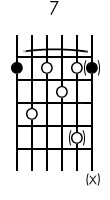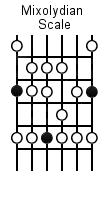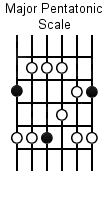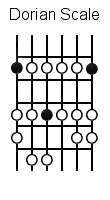This lesson offers the opportunity for learners to improvise guitar solos endlessly over a rhythm section backing track. It uses a Mixolydian Modal Groove. This is a bluesy vamp based on the Dominant 7 Chord. It is correct to call this “dominant 7” or just plain “7” chord. Here is a shape that you should be familiar with.

The blackened in dots represent the roots, or tonic of the chord. Move this chord around to make the different chords to follow this very common resolving cycle 5 root motion. In other words, the groove we will be using goes counterclockwise around this Cycle of 5s.
The music example is a rhythm section playing counterclockwise around the above cycle of 5ths chord motion.
First Step: Play the Chord with the Example
First step for the student would be to play the dominant 7 chord given above, or some variation. You could use any form. In fact, at some point you should explore using all the different variations and forms of this chord. But for brevity and to get to the meat and potatoes of this material, we’ll justgive the one form with the root on the 6th string. You should practice playing this chord along with the rhythm section accompaniment first.
Next Step: Play a Scale along with the Example
Once you understand how this chord change works, how the music follows this cycle, next choose a scale to work within. Start with one you are familiar with. Figure out how to carry this around the cycle in the same way the music does first. Let’s start with the minor pentatonic scale.
The minor pentatonic is going to sound a little forced. To me, this is that trippy, psychadelic sound from the 60s and 70s. The minor third doesn’t quite fit. It bends it into the blue! In fact, it sounds really cool to bend the second note, the minor 3rd above the root. Bend it toward the major 3rd. Dont quite get it there for a real hip sound! I think so, anyway. This is the essence of the blues in this minor/major 3rd blending. Don’t have a clue what I am talking about? Contact me, Chris at chris@doubleplanet.com
Super Chops
Typically a person improvising their guitar solo would utilize elements of phrasing, silences, sounds, dissonances, and resolution of these in order to create a tasteful flow, and a musicalness to the whole thing. Well, in super chops the idea is to omit the resting part.
Get within a scale or two and start your picking hand on swing 8th notes, for example. Now, never pause the right hand with this pattern. Keep it moving.
This creates a very busy solo. It is hard to do also. Try it! No pauses on the picking hand. Only consistant swing 8ths. Its like Bebop! If you get lost, or paint yourself in a corner, it’s okay to pause the hand that frets the guitar. You can stay on a note while still playing swing 8th pattern in the right hand. Try this with the different scales.
Incorporate Some Other Scales
To me, scales are like a way to organize notes into colors. Each scale has its own unique mood, or flavor. To get the most out of this material, try playing along with the music example with various scales that would work well over this groove. Here are a few of my favorites. Try them one at a time using super chops.
Mixolydian will sound the most “in” because this is really the scale that the groove in the music example is based on. Major Pentatonic will have even less “color” to it. The hybrid scale pictured is a blend of the major and minor pentatonic scales together. This creates some cool color. Kinda blue, with a little purple! This has some groovy chromaticisms in it, but be careful what note you land on!
Notice this hybrid scale also contains all of the notes of both the mixolydian scale and the dorian scale. Here is the dorian scale for one more that works, but is very blue because of the minor 3.
There are more scales that will fit here. Do you know them? Need help? Contact me, Chris at chris@doubleplanet.com





